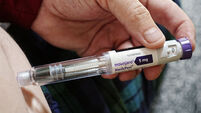Wet weather fungus boom
The whole forest actually smells of mushrooms at present.
It’s old, mixed-species woodland, slightly neglected, where many fallen trees and branches are left to rot where they lie. This is ideal fungus habitat, though they’re not, of course, restricted to woods. Some species grow in grassland, or even on dung-heaps, and a remarkable number grow on peat-land.
And although many species fruit in autumn in this country, fruiting bodies of some species or other can be found in every month of the year.
I find them fascinating and beautiful — a lot of them are also very good to eat — and over the years I’ve been trying to learn more about them.
The difficulty in identifying fungi is caused by the fact that there are so many different kinds.
There are probably between 2,500 and 3,000 different species of the large fungi in Ireland. The small species are close to uncountable — remember that slimes, moulds, yeasts, dry rot and penicillin all belong to the fungus kingdom.
Roger Phillips’ great book ‘Mushrooms and other Fungi of Great Britain and Europe’ is illustrated with colour photographs. After five years work by a team of experts, he only managed to photograph 914 species. I can only identify a fraction of these in the wild.
But I’ve found that my fascination with fungi is not shared with many people. Most of our new immigrants, particularly those from Eastern Europe, have a positive attitude to them, particularly the edible species.
In some European countries pharmacists are taught fungus recognition at college and you can take a basket of wild mushrooms into the chemist’s shop and be reassured that they’re safe to eat.
But most Irish people, if they eat wild fungi at all, restrict themselves to one species, the field mushroom. The rest they regard with distrust or even fear. The same is largely true in Britain but not in the rest of Europe.
There must be some cultural reason why we have a fungus phobia in these islands. The best explanation seems rather far-fetched at first sight.
In pre-Christian times and, to a lesser extent, in more recent history mushrooms have been associated with magic, witchcraft and the realm of the fairies. But the more you investigate this theory the less far-fetched it appears.
The fungus ergot grows on the stems of grasses and grains and is toxic.
It has been responsible for thousands, perhaps millions, of human deaths over the centuries. But in smaller quantities it is hallucinogenic. In fact when the active ingredient is synthesised in a laboratory it is called LSD.
Apparently medieval witches used to rub a paste of ergot on a stick or broom handle and then place this between their legs. The drug was then absorbed, I’m trying to be delicate here, by their mucus membranes. The commonest form of the hallucination was the illusion that they could fly.
In fact they were just ‘high’ or ‘on a trip’.
Another hallucinogenic mushroom that grows in Ireland is fly agaric. It’s red and white. In northern Europe it is, or was, used by shamans or holy men and also eaten by reindeer. The shamans when they were under the influence used to enter people’s huts by the smoke-hole in the roof and use their drug-induced magic to heal the sick.
Santa with his red and white robes, flying reindeer and habit of coming down the chimney with a gift is actually all about the cult of a red and white mushroom called fly agaric.
* dick.warner@examiner.ie














